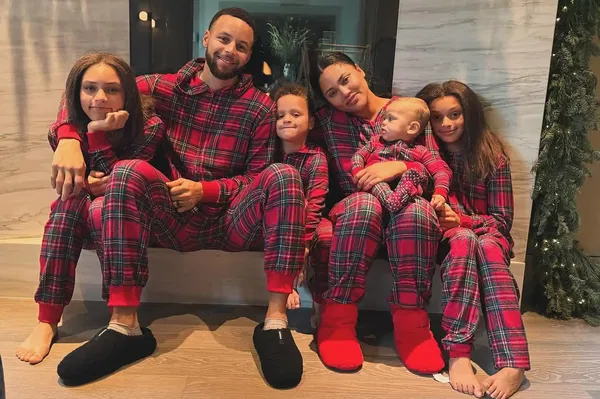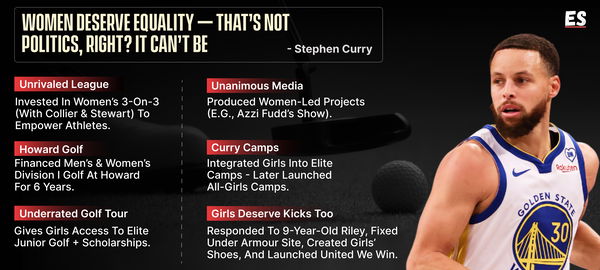
Imago
IMAGN

Imago
IMAGN
There are stars who score points, and then there are stars who change landscapes. Stephen Curry has done both, but the second part is the story most people miss. While the NBA box score tells you all about his threes, the deeper box score, the one history has specially engraved, includes his glorious imprint on women’s sports. This isn’t about courtside appearances or Instagram reposts — that’s surface-level coverage, and it’s been done every week. What matters is how he’s helping rewire an entire ecosystem. Something that is intentional, and long overdue.
Watch What’s Trending Now!
That’s what drew us here. Through years of empty gestures around women’s equality in sports. Speeches that sound good, hashtags that fade, promises that don’t stretch beyond a press release…
Stephen Curry has done something different.
ADVERTISEMENT
He’s rewiring the system itself (don’t mind me repeating), and it’s rooted in a personal stake that began at home but now spans the entire sports landscape. He’s built platforms where women athletes stand taller, and this is important, as they stay standing even when the spotlight moves on.
Think about it yourself. When a global icon calls out his own ‘shoe mistake’ for failing little girls, or funds a women’s golf program until it can sustain itself, or gives a young woman editorial control through his media company?
That’s infrastructure.
ADVERTISEMENT
Even Adam Silver has praised him as much for the influence he’s got on the entire league and beyond. Infrastructure lives longer than applause. And the public deserves to see it. Not just as Curry fans, but as witnesses to a model any superstar could follow. Because women’s sports are at an inflection point.
Deals are multiplying. Audiences are expanding. But visibility and perception? It’s fragile. Mentioning the WNBA can still be enough to draw smirks, even among people who live and breathe basketball. Yet when the conversation shifts to the NBA, the same perspective suddenly carries weight…
ADVERTISEMENT
Curry, in his own way, has been trying to close the gap. It’s why his decisions matter more than the feel-good headline.
Why gender equality in sports became “personal” for Stephen Curry
Back in 2018, Curry wrote a Players’ Tribune essay that still stays with me. He admitted something most athletes don’t: the issue of women’s equality got “a little more personal” after his daughter Riley told him she wanted to be “a basketball player cook.” That was her world at the time. A mixture of what she saw and believed was possible. Curry didn’t brush it off. He translated it into a responsibility. His words carried a sharpness you don’t always see from superstars.
ADVERTISEMENT
“Women deserve equality—that’s not politics, right? That’s not something that people are actually disagreeing on, is it? It can’t be.”
He credited Ayesha, his wife, and his mother, Sonya, as the anchors of that perspective. But there’s also a family branch that connects directly to women’s basketball. His god-sister is Cameron Brink, now a star in the WNBA. Brink has spoken openly about Curry’s presence in her life, being bigger than basketball. You can’t ignore how much those personal ties added urgency to his advocacy. But then came the moment that proved this wasn’t just family loyalty.
ADVERTISEMENT

In late 2018, a 9-year-old named Riley Morrison wrote Steph Curry a letter asking why his Under Armour shoes weren’t listed in girls’ sizes. “I hope you can work with Under Armour to change this because girls want to rock Curry 5’s too,” she wrote.
Curry responded, not just with a polite thank you, but with action. Within two days, the labeling was fixed. Then came a special edition Curry 6 designed with her, and eventually Under Armour’s “United We Win” campaign tied to International Women’s Day. Now, that moment was more than a marketing pivot.
It was proof.
Proof that visibility problems in women’s sports can be solved when someone with clout chooses to listen. Steve Kerr, Curry’s long-standing coach, has highlighted the rare extent to which Curry uses his influence beyond the basketball court.
As Kerr noted in interviews, “You know, somebody who makes a big difference in his community with his charitable work. Steph’s got all his ducks in a row, and I think that matters.” He embodies a commitment to social causes that feels as powerful as his game-winning shots.
It was no longer just about his daughters, or his god-sister, or the women closest to him. Curry had built a template to listen, act, and institutionalise change. Three steps easier said than done (not for Curry, though). What makes Curry’s approach so interesting is that he didn’t stop at shoes.
Stephen Curry’s investments in women’s sports
Curry’s most recent move came when he joined forces with players like Giannis Antetokounmpo to back Unrivaled, a new women’s 3-on-3 basketball league spearheaded by Breanna Stewart and Napheesa Collier. Curry put money on the table. His public statement about “empowering athletes” and creating opportunities for women was the fuel.
He said, “I am incredibly proud to join the Unrivaled family as the league continues to set a new standard for how women’s professional sports should operate — empowering athletes and ensuring they have a real stake in their own success…” Here’s where the Curry-Kobe parallel becomes all the more interesting!
Kobe Bryant’s late years were marked by his relentless push for women’s basketball, even Curry acknowledges it: “He was the first one I saw consistently and to the masses promoting it… He was an unbelievable role model in terms of putting his name and stamp on women’s basketball as something to invest in.”
So naturally, the Splash Bro has carried that baton forward. He’s been consistent about showing up for women’s hoops. And if you look back, you see him bending structures in impactful ways. Take Howard University golf, for one.

In 2019, Stephen Curry funded the return of Division I golf programs for both men and women. Six years of financing, front-loaded so the program could eventually sustain itself. That meant young women golfers at Howard weren’t treated like add-ons. They had an equal footing from day one. He didn’t have to do that. But he did. Then there’s Underrated Golf, his junior tour.
From the start, it integrated girls into the competition structure. Scholarships, visibility, real stakes. Golf has been historically exclusive, especially at the elite level. Curry reframed it to say: Not anymore. And, the fact that he did this outside basketball, shows that his philosophy isn’t confined to one sport. Through his media company, Unanimous Media, he’s extended that platform further.
One of the clearest examples is Azzi Fudd’s new show, which he co-produced. Giving a young woman athlete editorial control and distribution through his own channels is the kind of backing that can change how the next generation of fans consumes women’s sports. He even turned his elite boys’ camp into a co-ed proving ground. In 2018, Azzi Fudd and Cameron Brink were among the first women invited to compete. The following year, he launched an all-girls camp.
I think it was also the sort of thing that can help to shift people’s perspectives. So that when someone sees an NBA player is hosting a camp, now, you know — maybe they won’t automatically assume it’s for boys. And so eventually we can get to a place where the women’s game, it isn’t “women’s basketball.” It’s just basketball. Played by women, and celebrated by everyone – an impactful snippet from Curry’s Players’ Tribune writeup from 2018.
That’s institutional memory being built in real time. Those girls are now WNBA players, carrying forward the same visibility Curry fought to normalize. And the NBA noticed. Commissioner Adam Silver has gone on record saying Curry’s style of play below the rim, based on skill, actually helps drive interest in women’s basketball.
“I actually think the growth we’ve seen in women’s basketball is directly connected to Steph, too, because he plays below the rim,” Silver said. A nod to something larger. Curry’s game itself has softened old narratives about who gets to dominate on the court.
Even within his own household, Curry has seen the ripple effects. His daughter Riley has dabbled in volleyball, challenging another gender line narrative that still feels stubborn. Maybe it’ll be hoops. Maybe not. The point is, Curry’s advocacy has always been about possibility. Not telling girls what to dream. Just making sure the world doesn’t shrink their options.
That’s what separates Curry in this conversation.
Plenty of athletes support women’s sports, but few build a scaffolding. He’s present in the machinery. That’s what makes the discussion around his role feel urgent.
The story here isn’t just about Stephen Curry, the NBA star.
It’s about Stephen Curry, the system re-designer. Women’s sports are moving into a defining decade.
The WNBA is carving out mainstream media space that once seemed unreachable. The WNBPA is pushing the league harder than ever on a fair compensation split and player perks. And with each new viewer, the question surfaces: Who helped make the foundation strong enough to sustain it?
The answer, in part, is Stephen Curry.
And that’s not a compliment. It’s a fact.
Because once you’ve changed the geometry of basketball, maybe it’s only natural you’d start redrawing the blueprint for the rest of sports too.
ADVERTISEMENT
ADVERTISEMENT
ADVERTISEMENT

